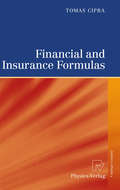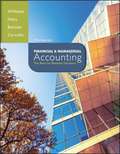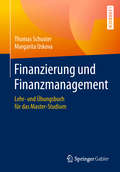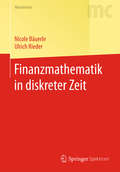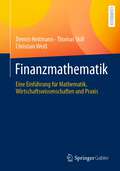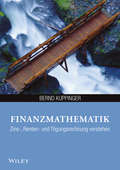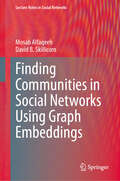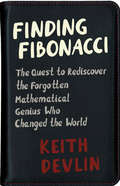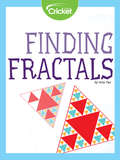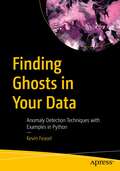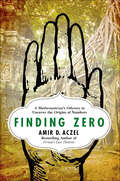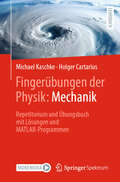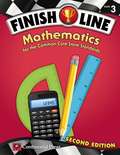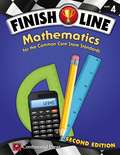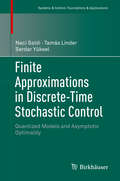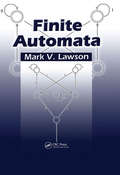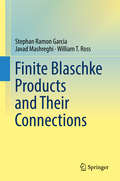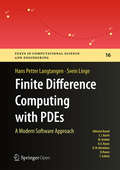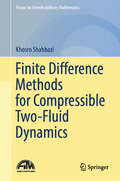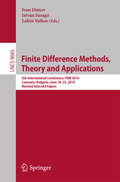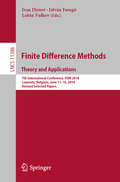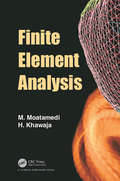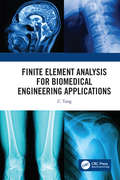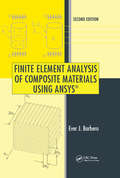- Table View
- List View
Financial and Insurance Formulas
by Tomas CipraThis survey contains more than 3,000 formulas and methods from the field of finance and insurance mathematics (as well as related formulas in mathematics, probability theory, statistics, econometrics, index numbers, demography, stochastic processes and time series). The formulas are mostly applicable in financial and actuarial practice. Their mathematical level ranges from simple ones based on arithmetic to very sophisticated matters of higher mathematics (e. g. stochastic calculus), but they are usually presented in the form most frequently used in applications. Explanations and references to related parts of the survey are given so that one can easily browse and look them up in the text; the detailed Index is also helpful for this purpose. The survey will be of benefit for students, researchers and practitioners in finance and insurance.
Financial and Managerial Accounting (Seventeenth Edition)
by Jan Williams Joseph Carcello Mark Bettner Susan HakaWith the seventeenth edition of Financial and Managerial Accounting: The Basis for Business Decisions, the Williams author team continues to be a solid foundation for students who are learning basic accounting concepts. Hallmarks of the text - including the solid Accounting Cycle Presentation, relevant pedagogy, and high quality, end-of-chapter material--have been updated throughout the book.
Finanzierung und Finanzmanagement: Lehr- Und Übungsbuch Für Das Master-studium
by Thomas Schuster Margarita UskovaDas Buch bietet eine sehr praxisorientierte und vertiefte Darstellung eines Unternehmens. Nach einem kurzen Überblick über die Grundlagen des Finanzmanagements lernt der Leser die Einzelheiten der Beteiligungs-, Fremd- und Innenfinanzierung kennen. Außerdem werden Finanzderivate wie zum Beispiel Optionen und Forward Rate Agreements dargestellt. Ein Kapitel über alternative Finanzierungsinstrumente, beispielsweise Factoring oder Leasing, runden das Lehrbuch ab. In jedem Kapitel führt ein Fallbeispiel in das Wissensgebiet ein. Die einzelnen Themen werden anschaulich durch viele Praxisbeispiele illustriert. Lernkontrollaufgaben dienen der Absicherung, dass der Leser den gelernten Stoff gut verstanden hat. Es handelt sich um ein sehr modernes Lehrbuch mit der konsequenten Verbindung von Theorie, Praxisbeispielen und vertiefenden Übungsaufgaben. Studierende finden zusätzliche Übungsaufgaben und Lösungen auf der Internetseite des Verlags. Für Lehrende werden weitere Materialien – bespielsweise PowerPoint-Folien und Klausuren – auf der Springer-Seite DozentenPLUS bereitgestellt. Das Buch wendet sich an Master-Studierende mit wirtschaftswissenschaftlichem Schwerpunkt, MBA-Studierende sowie an Praktiker in Finanzabteilungen von Unternehmen.
Finanzmathematik in diskreter Zeit
by Ulrich Rieder Nicole BäuerleDieses Lehrbuch bietet eine leicht verständliche Einführung in die moderne Finanzmathematik und erläutert grundlegende mathematische Konzepte der Optionsbewertung, der Portfolio-Optimierung und des Risikomanagements. Hierzu gehören die Preisbestimmung durch Arbitrageüberlegungen, die Preisbestimmung von amerikanischen Optionen über die Lösung optimaler Stopp-Probleme, die Bestimmung von optimalen Konsum- und Investitionsstrategien und Erwartungswert-Varianz Portfolios. Aktuelle Konzepte der Risikomessung wie Value at Risk und Expected Shortfall werden ebenso vorgestellt.Grundlagen in Stochastik und Optimierung reichen für das Verständnis der Inhalte aus und zahlreiche Übungsaufgaben mit ausführlichen Lösungen sowie drei Anhänge erleichtern das Selbststudium.
Finanzmathematik: Eine Einführung für Mathematik, Wirtschaftswissenschaften und Praxis
by Christian Weiß Thomas Skill Dennis HeitmannBei der Anwendung finanzmathematischer Modelle im beruflichen Alltag ist es ein entscheidender Erfolgsfaktor, die Verknüpfung von Theorie und Praxis zu verstehen. Dieses Buch verbindet daher die Präsentation der Theorie hinter den zentralen Themen der Finanzmathematik durchgehend mit vielen Beispielen aus einem konkreten Anwendungsfeld. Dabei bringen die Autoren fortwährend ihre langjährigen Erfahrungen als Berufstätige in der Finanzbranche und als Wissenschaftler ein. In besonderer Weise richtet sich dieses Buch dadurch an Studierende der Mathematik, der Betriebs- und der Volkswirtschaftslehre, die sich für einen Schwerpunkt in Finanzmärkten und Anlagestrategien interessieren. Ergänzt wird die klare und verständliche Darstellung durch mehr als 60 Aufgaben inklusive Lösungen, die auch als Onlineressourcen in Excel umgesetzt und verfügbar sind. Damit keine weitere Literatur zu erforderlichen Vorkenntnissen herangezogen werden muss, sind in einem Anhang die notwendigen Grundlagen aus der Wirtschaftsmathematik und Statistik in kompakter und übersichtlicher Form zusammengefasst, sodass das vorliegende Buch auch für das Selbststudium hervorragend genutzt werden kann. Dadurch ist es ebenfalls im hohen Maße für Berufstätige aus der Praxis geeignet, die einen Hintergrund in den Wirtschaftswissenschaften oder der Mathematik mitbringen und auf der Suche nach einer anschaulichen und praxisorientierten Einführung sind oder ihr Wissen auffrischen möchten.
Finanzmathematik: Zins-, Renten- und Tilgungsrechnung verstehen (Studienbücher Wirtschaftsmathematik Ser.)
by Bernd KuppingerDie Finanzmathematik ist unter Wirtschaftswissenschaftlern nicht immer beliebt. Sie gilt als kompliziert und recht lernintensiv. Bernd Kuppinger will Ihnen in diesem Buch zeigen, dass das nicht so sein muss. Er erklärt Ihnen so verständlich wie möglich, was Sie über Zins-, Renten- und Tilgungsrechnung wissen müssen. Er gibt eine Einführung in die Investitionsrechnung und bringt Ihnen in einem eigenen Teil auch noch das mathematische Handwerkszeug näher, das Sie brauchen, um in der Finanzmathematik zu bestehen. Viele Beispiele helfen Ihnen, den Bezug zur Praxis herzustellen, und mit den zahlreichen Übungsaufgaben können Sie Ihr Wissen festigen und testen.
Finding Communities in Social Networks Using Graph Embeddings (Lecture Notes in Social Networks)
by David B. Skillicorn Mosab AlfaqeehCommunity detection in social networks is an important but challenging problem. This book develops a new technique for finding communities that uses both structural similarity and attribute similarity simultaneously, weighting them in a principled way. The results outperform existing techniques across a wide range of measures, and so advance the state of the art in community detection. Many existing community detection techniques base similarity on either the structural connections among social-network users, or on the overlap among the attributes of each user. Either way loses useful information. There have been some attempts to use both structure and attribute similarity but success has been limited. We first build a large real-world dataset by crawling Instagram, producing a large set of user profiles. We then compute the similarity between pairs of users based on four qualitatively different profile properties: similarity of language used in posts, similarity of hashtags used (which requires extraction of content from them), similarity of images displayed (which requires extraction of what each image is 'about'), and the explicit connections when one user follows another. These single modality similarities are converted into graphs. These graphs have a common node set (the users) but different sets a weighted edges. These graphs are then connected into a single larger graph by connecting the multiple nodes representing the same user by a clique, with edge weights derived from a lazy random walk view of the single graphs. This larger graph can then be embedded in a geometry using spectral techniques. In the embedding, distance corresponds to dissimilarity so geometric clustering techniques can be used to find communities. The resulting communities are evaluated using the entire range of current techniques, outperforming all of them. Topic modelling is also applied to clusters to show that they genuinely represent users with similar interests. This can form the basis for applications such as online marketing, or key influence selection.
Finding Fibonacci: The Quest to Rediscover the Forgotten Mathematical Genius Who Changed the World
by Keith DevlinIn 2000, Keith Devlin set out to research the life and legacy of the medieval mathematician Leonardo of Pisa, popularly known as Fibonacci, whose book Liber abbaci has quite literally affected the lives of everyone alive today. Although he is most famous for the Fibonacci numbers—which, it so happens, he didn't invent—Fibonacci's greatest contribution was as an expositor of mathematical ideas at a level ordinary people could understand. In 1202, Liber abbaci—the "Book of Calculation"—introduced modern arithmetic to the Western world. Yet Fibonacci was long forgotten after his death, and it was not until the 1960s that his true achievements were finally recognized.Finding Fibonacci is Devlin's compelling firsthand account of his ten-year quest to tell Fibonacci's story. Devlin, a math expositor himself, kept a diary of the undertaking, which he draws on here to describe the project's highs and lows, its false starts and disappointments, the tragedies and unexpected turns, some hilarious episodes, and the occasional lucky breaks. You will also meet the unique individuals Devlin encountered along the way, people who, each for their own reasons, became fascinated by Fibonacci, from the Yale professor who traced modern finance back to Fibonacci to the Italian historian who made the crucial archival discovery that brought together all the threads of Fibonacci's astonishing story.Fibonacci helped to revive the West as the cradle of science, technology, and commerce, yet he vanished from the pages of history. This is Devlin's search to find him.
Finding Fractals
by Amy TaoHave you ever seen a fractal? You probably have, and just didn’t know it! These repeating shapes can happen anywhere, whether in nature or in math—it’s easy to make one out of a series of lines and triangles! Follow along and make a fractal of your own in a fun craft.
Finding Ghosts in Your Data: Anomaly Detection Techniques with Examples in Python
by Kevin FeaselDiscover key information buried in the noise of data by learning a variety of anomaly detection techniques and using the Python programming language to build a robust service for anomaly detection against a variety of data types. The book starts with an overview of what anomalies and outliers are and uses the Gestalt school of psychology to explain just why it is that humans are naturally great at detecting anomalies. From there, you will move into technical definitions of anomalies, moving beyond "I know it when I see it" to defining things in a way that computers can understand.The core of the book involves building a robust, deployable anomaly detection service in Python. You will start with a simple anomaly detection service, which will expand over the course of the book to include a variety of valuable anomaly detection techniques, covering descriptive statistics, clustering, and time series scenarios. Finally, you will compare your anomaly detection service head-to-head with a publicly available cloud offering and see how they perform.The anomaly detection techniques and examples in this book combine psychology, statistics, mathematics, and Python programming in a way that is easily accessible to software developers. They give you an understanding of what anomalies are and why you are naturally a gifted anomaly detector. Then, they help you to translate your human techniques into algorithms that can be used to program computers to automate the process. You’ll develop your own anomaly detection service, extend it using a variety of techniques such as including clustering techniques for multivariate analysis and time series techniques for observing data over time, and compare your service head-on against a commercial service.What You Will LearnUnderstand the intuition behind anomaliesConvert your intuition into technical descriptions of anomalous dataDetect anomalies using statistical tools, such as distributions, variance and standard deviation, robust statistics, and interquartile rangeApply state-of-the-art anomaly detection techniques in the realms of clustering and time series analysisWork with common Python packages for outlier detection and time series analysis, such as scikit-learn, PyOD, and tslearnDevelop a project from the ground up which finds anomalies in data, starting with simple arrays of numeric data and expanding to include multivariate inputs and even time series dataWho This Book Is ForFor software developers with at least some familiarity with the Python programming language, and who would like to understand the science and some of the statistics behind anomaly detection techniques. Readers are not required to have any formal knowledge of statistics as the book introduces relevant concepts along the way.
Finding Zero: A Mathematician's Odyssey to Uncover the Origins of Numbers
by Amir D. Aczel“A captivating story, not just an intellectual quest but a personal one . . . gripping [and] filled with the passion and wonder of numbers.” —The New York TimesVirtually everything in our lives is digital, numerical, or quantified. But the story of how and where we got these numerals, which we so depend on, has for thousands of years been shrouded in mystery. Finding Zero is the saga of Amir Aczel’s lifelong obsession: to find the original sources of our numerals, perhaps the greatest abstraction the human mind has ever created.Aczel has doggedly crisscrossed the ancient world, scouring dusty, moldy texts, cross-examining so-called scholars who offered wildly differing sets of facts, and ultimately penetrating deep into a Cambodian jungle to find a definitive proof. Here, he takes the reader along for the ride.The history begins with Babylonian cuneiform numbers, followed by Greek and Roman letter numerals. Then Aczel asks: Where do the numbers we use today, the so-called Hindu-Arabic numerals, come from? It is this search that leads him to explore uncharted territory on a grand quest into India, Thailand, Laos, Vietnam, and ultimately into the wilds of Cambodia. There he is blown away to find the earliest zero—the keystone of our entire system of numbers—on a crumbling, vine-covered wall of a seventh-century temple adorned with eaten-away erotic sculptures.While on this odyssey, Aczel meets a host of fascinating characters: academics in search of truth, jungle trekkers looking for adventure, surprisingly honest politicians, shameless smugglers, and treacherous archaeological thieves—who finally reveal where our numbers come from.“A historical adventure that doubles as a surprisingly engaging math lesson . . . rip-roaring exploits and escapades.” —Publishers Weekly
Finding the Speed of Light: The 1676 Discovery That Dazzled The World
by Mark WestonKirkus Star Mark Weston’s high-interest story and Rebecca Evans’s colorful graphics make scientific discovery the coolest thing this side of Jupiter. More than two centuries before Einstein, using a crude telescope and a mechanical timepiece, Danish astronomer Ole Romer measured the speed of light with astounding accuracy. How was he able to do this when most scientists didn’t even believe that light traveled? Like many paradigm-shattering discoveries, Romer’s was accidental. Night after night he was timing the disappearance and reappearance of Jupiter’s moon Io behind the huge, distant planet. Eventually he realized that the discrepancies in his measurements could have only one explanation: Light had a speed, and it took longer to reach Earth when Earth was farther from Jupiter. All he needed then to calculate light’s speed was some fancy geometry.
Fingerübungen der Physik: Repetitorium und Übungsbuch mit Lösungen und MATLAB-Programmen
by Michael Kaschke Holger CartariusDieses Lehr- und Lernbuch erscheint in mehreren Bänden und ist gleichsam ein Repetitorium als auch Arbeitsbuch zu wenig behandelten Kapiteln des Physikstudiums. In diesem Band wird die Physik der Bewegung von Körpern und des Kontinuums behandelt. Zahlreiche spannende Probleme aus dem Alltag, der Physikgeschichte und der modernen Forschung werden sowohl anschaulich erklärt als auch mathematisch-physikalisch beschrieben. Die ausführlichen Lösungsvorschläge mit MATLAB-Programmen dienen dabei als „Fingerübungen“ für ein tieferes physikalisches Verständnis. Der Inhalt Physik der Bewegung – Physik des Kontinuums Die Zielgruppe Das Buch richtet sich an alle, die Freude an der Physik haben und diese für verschiedene Fragestellungen anwenden wollen. Besonderen Nutzen daraus werden Studierende und Promovierende der Physik, Mathematik und Ingenieurswissenschaften, ebenso wie des Lehramtes für naturwissenschaftliche Fächer gewinnen. Genauso ist das Buch für Dozentinnen und Dozenten der Physik an Hochschulen und Universitäten gedacht, aber auch für Lehrkräfte der Physik an Gymnasien, die aus dem Fundus der Übungen und Beispiele Anregungen für eigene Problemstellungen und Projekte gewinnen können. Vorkenntnisse Das Physikwissen des Bachelor-Studiums stellt in etwa die Grundlage dar, auf der das Buch aufbaut. Eine Reihe von Kapiteln lassen sich auch mit den Kenntnissen eines Leistungskurses Physik an den Gymnasien erschließen. Die Übungsaufgaben sind nach 3 Schwierigkeitsklassen gegliedert.
Finish Line Mathematics for The Common Core State Standards Grade 3
by Continental Press StaffThe Finish Line Mathematics for the Common Core State Standards workbook provides instruction and practice for the Common Core State Standards for Mathematics recently adopted by your state. Lessons emphasize rigor of text and higher-order thinking skills, and focus on development of the process skills. The format features instruction with step-by-step examples, guided practice, and independent work. Students will answer selected response, constructed-response, and extended-response questions. To align with the Common Core requirements, Finish Line practice builds on the underlying structure of mathematics to prepare students for algebra by the end of grade 7. Reviews at the end of each unit and a practice test at the end of the book help you monitor progress.
Finish Line Mathematics for the Common Core State Standards Grade 4
by Continental Press StaffFinish Line Mathematics for the Common Core State Standards will help you prepare for math tests. Each year in math class, you learn new skills and ideas. This book focuses on the math skills and ideas that are the most important for each grade. It is important to master the concepts you learn each year because mathematical ideas and skills build on each other. The things you learn this year will help you understand and master the skills you will learn next year.
Finite Approximations in Discrete-Time Stochastic Control: Quantized Models And Asymptotic Optimality (Systems And Control: Foundations And Applications Ser.)
by Serdar Yüksel Naci Saldi Tamás LinderIn a unified form, this monograph presents fundamental results on the approximation of centralized and decentralized stochastic control problems, with uncountable state, measurement, and action spaces. It demonstrates how quantization provides a system-independent and constructive method for the reduction of a system with Borel spaces to one with finite state, measurement, and action spaces. In addition to this constructive view, the book considers both the information transmission approach for discretization of actions, and the computational approach for discretization of states and actions. Part I of the text discusses Markov decision processes and their finite-state or finite-action approximations, while Part II builds from there to finite approximations in decentralized stochastic control problems. This volume is perfect for researchers and graduate students interested in stochastic controls. With the tools presented, readers will be able to establish the convergence of approximation models to original models and the methods are general enough that researchers can build corresponding approximation results, typically with no additional assumptions.
Finite Automata
by Mark V. LawsonInterest in finite automata theory continues to grow, not only because of its applications in computer science, but also because of more recent applications in mathematics, particularly group theory and symbolic dynamics. The subject itself lies on the boundaries of mathematics and computer science, and with a balanced approach that does justice to
Finite Blaschke Products and Their Connections
by Javad Mashreghi Stephan Ramon Garcia William T. RossThis monograph offers an introduction to finite Blaschke products and their connections to complex analysis, linear algebra, operator theory, matrix analysis, and other fields. Old favorites such as the Carathéodory approximation and the Pick interpolation theorems are featured, as are many topics that have never received a modern treatment, such as the Bohr radius and Ritt's theorem on decomposability. Deep connections to hyperbolic geometry are explored, as are the mapping properties, zeros, residues, and critical points of finite Blaschke products. In addition, model spaces, rational functions with real boundary values, spectral mapping properties of the numerical range, and the Darlington synthesis problem from electrical engineering are also covered.Topics are carefully discussed, and numerous examples and illustrations highlight crucial ideas. While thorough explanations allow the reader to appreciate the beauty of the subject, relevant exercises following each chapter improve technical fluency with the material. With much of the material previously scattered throughout mathematical history, this book presents a cohesive, comprehensive and modern exposition accessible to undergraduate students, graduate students, and researchers who have familiarity with complex analysis.
Finite Difference Computing with PDEs
by Svein Linge Hans Petter LangtangenThis easy-to-read book introduces the basics of solving partial differential equations by means of finite difference methods. Unlike many of the traditional academic works on the topic, this book was written for practitioners. Accordingly, it especially addresses: the construction of finite difference schemes, formulation and implementation of algorithms, verification of implementations, analyses of physical behavior as implied by the numerical solutions, and how to apply the methods and software to solve problems in the fields of physics and biology. This book is open access under a CC BY license.
Finite Difference Methods for Compressible Two-Fluid Dynamics (Forum for Interdisciplinary Mathematics)
by Khosro ShahbaziFinite Difference Methods for Compressible Two-Fluid Dynamics provides the essentials of high-order numerical methods for compressible single-fluid and two-fluid transport phenomena. This book can serve as a first course on the numerical methods for transport phenomena or fluid dynamics for students in mechanical, aerospace, and chemical engineering, applied mathematics, and physics at the senior level of an undergraduate or graduate degree. It also provides foundations and algorithmic details for implementing the most recent numerical schemes for compressible flows and extending them to include other physics, such as elasticity, reaction, and magnetohydrodynamics. The book's presented schemes enable computations for broad applications, including shock-induced interfacial instability and turbulence, shock-bubble interactions, and detonation, to name a few. For a broad reach and impact, the numerical schemes satisfy the simultaneous requirements of simplicity, extendibility, and efficiency on serial and parallel computers. The physics of the compressible single- and two-fluid system also guide the design and analysis of the numerical methods. The enabled direct numerical simulations also help obtain accurate data for tuning the emerging physics-based neuromorphic algorithms.
Finite Difference Methods,Theory and Applications
by Ivan Dimov István Faragó Lubin VulkovThis book constitutes the thoroughly refereed post-conference proceedings of the 6th International Conference on Finite Difference Methods, FDM 2014, held in Lozenetz, Bulgaria, in June 2014. The 36 revised full papers were carefully reviewed and selected from 62 submissions. These papers together with 12 invited papers cover topics such as finite difference and combined finite difference methods as well as finite element methods and their various applications in physics, chemistry, biology and finance.
Finite Difference Methods. Theory and Applications: 7th International Conference, FDM 2018, Lozenetz, Bulgaria, June 11-16, 2018, Revised Selected Papers (Lecture Notes in Computer Science #11386)
by Ivan Dimov István Faragó Lubin VulkovThis book constitutes the refereed conference proceedings of the 7th International Conference on Finite Difference Methods, FDM 2018, held in Lozenetz, Bulgaria, in June 2018.The 69 revised full papers presented together with 11 invited papers were carefully reviewed and selected from 94 submissions. They deal with many modern and new numerical techniques like splitting techniques, Green’s function method, multigrid methods, and immersed interface method.
Finite Element Analysis
by M Moatamedi Hassan A. KhawajaFinite element analysis has become the most popular technique for studying engineering structures in detail. It is particularly useful whenever the complexity of the geometry or of the loading is such that alternative methods are inappropriate. The finite element method is based on the premise that a complex structure can be broken down into finitely many smaller pieces (elements), the behaviour of each of which is known or can be postulated. These elements might then be assembled in some sense to model the behaviour of the structure. Intuitively this premise seems reasonable, but there are many important questions that need to be answered. In order to answer them it is necessary to apply a degree of mathematical rigour to the development of finite element techniques. The approach that will be taken in this book is to develop the fundamental ideas and methodologies based on an intuitive engineering approach, and then to support them with appropriate mathematical proofs where necessary. It will rapidly become clear that the finite element method is an extremely powerful tool for the analysis of structures (and for other field problems), but that the volume of calculations required to solve all but the most trivial of them is such that the assistance of a computer is necessary. As stated above, many questions arise concerning finite element analysis. Some of these questions are associated with the fundamental mathematical formulations, some with numerical solution techniques, and others with the practical application of the method. In order to answer these questions, the engineer/analyst needs to understand both the nature and limitations of the finite element approximation and the fundamental behaviour of the structure. Misapplication of finite element analysis programs is most likely to arise when the analyst is ignorant of engineering phenomena.
Finite Element Analysis for Biomedical Engineering Applications
by Z. C. YangFinite element analysis has been widely applied to study biomedical problems. This book aims to simulate some common medical problems using finite element advanced technologies, which establish a base for medical researchers to conduct further investigations. This book consists of four main parts: (1) bone, (2) soft tissues, (3) joints, and (4) implants. Each part starts with the structure and function of the biology and then follows the corresponding finite element advanced features, such as anisotropic nonlinear material, multidimensional interpolation, XFEM, fiber enhancement, UserHyper, porous media, wear, and crack growth fatigue analysis. The final section presents some specific biomedical problems, such as abdominal aortic aneurysm, intervertebral disc, head impact, knee contact, and SMA cardiovascular stent. All modeling files are attached in the appendixes of the book. This book will be helpful to graduate students and researchers in the biomedical field who engage in simulations of biomedical problems. The book also provides all readers with a better understanding of current advanced finite element technologies. Details finite element modeling of bone, soft tissues, joints, and implants Presents advanced finite element technologies, such as fiber enhancement, porous media, wear, and crack growth fatigue analysis Discusses specific biomedical problems, such as abdominal aortic aneurysm, intervertebral disc, head impact, knee contact, and SMA cardiovascular stent Explains principles for modeling biology Provides various descriptive modeling files
Finite Element Analysis of Composite Materials Using ANSYS
by Ever J. BarberoDesigning structures using composite materials poses unique challenges, especially due to the need for concurrent design of both material and structure. Students are faced with two options: textbooks that teach the theory of advanced mechanics of composites, but lack computational examples of advanced analysis, and books on finite element analysis
